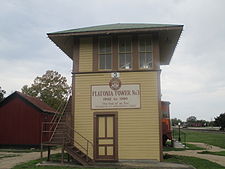Flatonia, Texas
| Flatonia, Texas | |
|---|---|
| Town | |

Flatonia Southern Pacific Tower (1902-1996)
|
|
| Motto: "Where All Roads Lead" | |
 Location of Flatonia, Texas |
|
| Coordinates: 29°41′13″N 97°6′28″W / 29.68694°N 97.10778°WCoordinates: 29°41′13″N 97°6′28″W / 29.68694°N 97.10778°W | |
| Country | United States |
| State | Texas |
| County | Fayette |
| Area | |
| • Total | 1.64 sq mi (4.24 km2) |
| • Land | 1.62 sq mi (4.19 km2) |
| • Water | 0.02 sq mi (0.04 km2) |
| Elevation | 456 ft (139 m) |
| Population (2010) | |
| • Total | 1,383 |
| • Density | 854/sq mi (329.8/km2) |
| Time zone | Central (CST) (UTC-6) |
| • Summer (DST) | CDT (UTC-5) |
| ZIP code | 78941 |
| Area code(s) | 361 |
| FIPS code | 48-26028 |
| GNIS feature ID | 1335937 |
| Website | www |
Flatonia is a town in southwestern Fayette County, Texas, United States. It is located on Interstate 10 and the Southern Pacific Railroad, 12 miles (19 km) west of Schulenburg. The population was 1,383 at the 2010 census.
Flatonia was established on April 8, 1874, on land that the Galveston, Harrisburg and San Antonio Railway acquired from William Alexander Faries (the family name is also spelled "Ferris" and "Farris"). The community, originally made up of Anglo American settlers, was named after F. W. Flato, a local merchant and one of the first settlers. Residents placed their homes in the former Flatonia settlement, one mile southeast of the current Flatonia, and in the community of Oso, 3 miles (5 km) northeast, on wagons and moved to the new location. The post office, established in the former Flatonia in 1870, moved to the new Flatonia with the same name. Flatonia was incorporated on November 10, 1875, and held its first election on December 6 of that year. In 1878 the town had 800 residents and an economy dependent on cattle and cotton.
The location of the railway and inexpensive real estate led to the arrival of Arab, Bohemian, German, Greek, and Italian immigrants in several waves. The north-south line of the Waco branch of the San Antonio and Aransas Pass Railway opened in the mid-1880s, leading to new settlements of Muldoon and Moulton. Competition from the settlements, respectively north and south of Flatonia, and an agricultural depression damaged Flatonia's economy. By 1900 Flatonia had a significant population decrease.
...
Wikipedia
